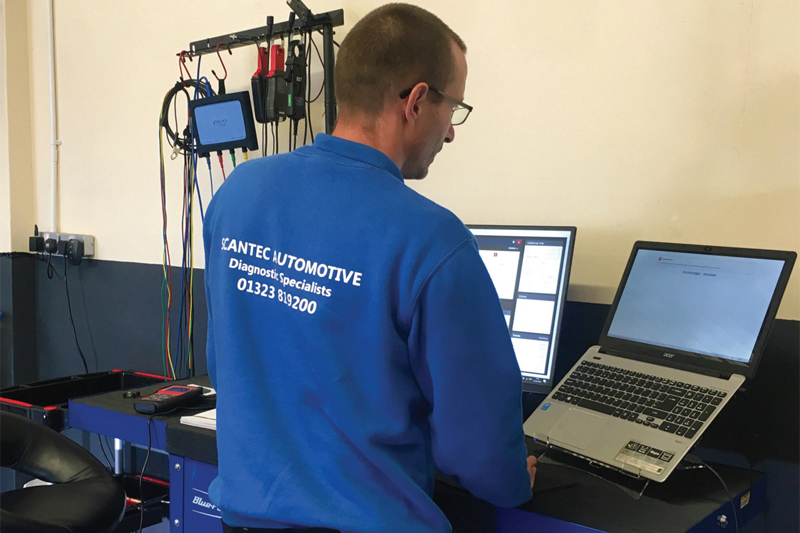
Ross Kemp of Scantec Automotive has spoken in previous issues of PMM about when to use aftermarket tools in the diagnostics process. However, he stresses that his businesses refuses to work on a vehicle, unless the specific dealer tool is available. Ross elaborates further.
As a diagnostic specialist workshop, we carry genuine dealer tools alongside some specialist and aftermarket tooling to give the best possible options when it comes to diagnostics. In a previous article, I explained the necessity of having both. This time around, I would like to outline a recent diagnostic job that highlights the reason why we won’t carry out diagnostics on brands we don’t have an official dealer tool for.
We recently carried out some diagnostic work for another workshop that we think highlights, in no uncertain terms, not only how the technology in our trade is changing, but also how moving forward is going to become increasingly difficult for those who are not investing in dealer tools.
A recent example that comes to mind was a 2015 Mercedes E-Class that was brought to the workshop with the customer complaining of a lit engine malfunction warning lamp, but with no starting and/or drivability issues.
As per our normal procedure, we connected our Mercedes diagnostic tester to the vehicle and carried out a full/global diagnostic fault scan and documented our findings. The initial scan showed a fault logged in the engine’s fault memory displaying:
P22AA – Heater of NOx sensor 2 has a malfunction.
A quick check of the circuit operation and some wiring checks against the official wiring diagrams confirmed very quickly that we did in fact have a failed NOx sensor. All fairly simple so far, you would think. Order a new sensor, reset faults, maybe even reset NOx adaptions – job done.
However, it might be worth pointing out that at this stage, we also checked for technical bulletins, as we were already aware of possible modifications to the NOx sensor that required software updates/changes to engine control module software. Yet, there were none listed, so you would presume that you are clear to order and fit a new sensor. You would be right to order a new sensor, as the fault code present and all testing confirmed the sensor had failed and required replacement.
However, without running the manufacturer’s test plan for faults via the dealer tool, you would be unaware of the modification to the sensors. This isn’t listed in technical service bulletins and to make matters worse, if you were to pick up the phone to Mercedes’ parts department and order a new NOx sensor, you would be supplied the original (unmodified) part with no mention whatsoever of the modification, as the manufacturers’ parts system will only have one listing for the NOx sensors and that will be the part number currently fitted to the vehicle.
The official repair that only appears on the guided test routine via the dealer tool is as follows:
1. Perform a retrofit of special equipment code ‘30o’ via Vdoc – requiring dealer tooling and official logins – essentially updating the vehicle specification on the Mercedes servers (Interestingly enough, once this had been completed, the idea was that the official parts server would then list the correct (modified) NOx sensor. However, in reality, we found the server actually updated almost straight away, with the parts system server taking some time to update. The parts department are unable to confirm the correct modified parts until this server update takes place. Luckily, as we had seen the issue before, we were able to order the correct NOx sensors without having to wait)
2. Replace both NOx sensors – Yes both, as the operating speed of the sensors has been modified, and therefore both sensors will be required
3. Reset NOx sensor learnt values
4. Carry out software update for engine, transmission & SCR modules – making sure that the special equipment code (in this case, code ‘30o’) had already been retrofitted, as not only does the software require updating, but the engine and SCR module updates would now also include the technical modification required when fitting the modified NOx sensors
5. Clear all faults
Going back to the original fault code on the initial diagnostic scan of P22AA Heater of NOx sensor, I don’t feel at all confident that we could have correctly diagnosed and rectified this issue without the information obtained via the dealer too – not to mention having access to Vedoc to modify the vehicle specification relevant to this modification.
Even if we had access to the correct modified NOx part numbers, unless we correctly modified the Vedoc server, each and every future purchase of a NOx sensor for this vehicle would include the wrong part number, which would in itself cause the vehicle to log NOx sensor faults.
And, even if we had access to a ‘dealer equivalent’ diagnostic tool that listed the technical aspects of this repair, I am certain we would still not have been able to carry out the correct software updates to include the all-important technical modification.









